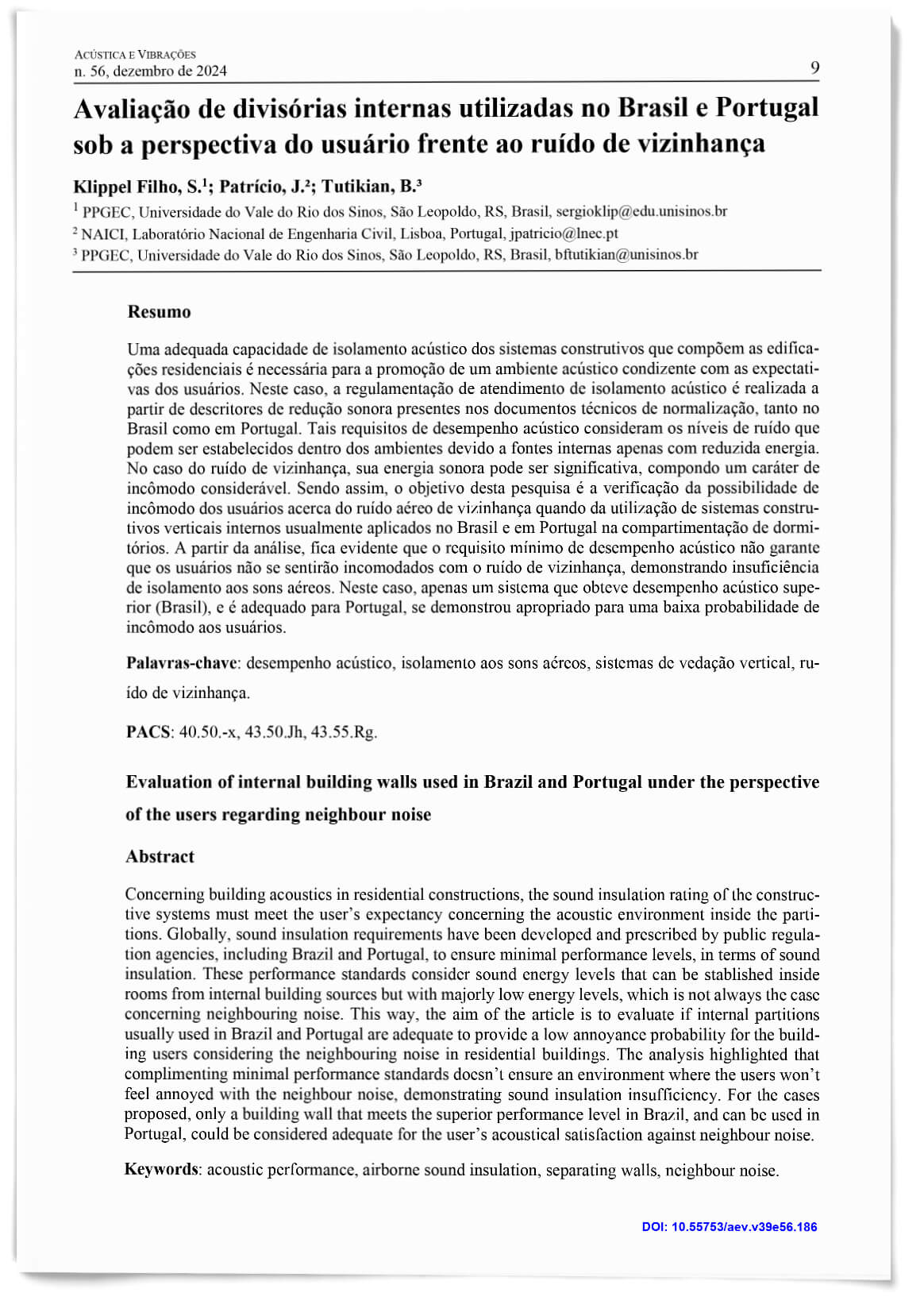Evaluation of internal building walls used in Brazil and Portugal under the perspec-tive of the users regarding neighbour noise
DOI:
https://doi.org/10.55753/aev.v39e56.186Keywords:
acoustic performance, airborne sound insulation, separating walls, neighbour noiseAbstract
Concerning building acoustics in residential constructions, the sound insulation rating of the constructive systems must meet the user’s expectancy concerning the acoustic environment inside the partitions. Globally, sound insulation requirements have been developed and prescribed by public regulation agencies, including Brazil and Portugal, to ensure minimal performance levels, in terms of sound insulation. These performance standards consider sound energy levels that can be stablished inside rooms from internal building sources but with majorly low energy levels, which is not always the case concerning neighbouring noise. This way, the aim of the article is to evaluate if internal partitions usually used in Brazil and Portugal are adequate to provide a low annoyance probability for the building users considering the neighbouring noise in residential buildings. The analysis highlighted that complimenting minimal performance standards doesn’t ensure an environment where the users won’t feel annoyed with the neighbour noise, demonstrating sound insulation insufficiency. For the cases proposed, only a building wall that meets the superior performance level in Brazil, and can be used in Portugal, could be considered adequate for the user’s acoustical satisfaction against neighbour noise.
References
HOPKINS, C. Sound insulation. 1. ed. Oxford: Elsevier, 2007.
RINDEL, J. H. Sound insulation in buildings. 1. ed. Boca Raton: Taylor & Francis Group LLC, 2018. DOI: https://doi.org/10.1201/9781351228206-2
ALLEN, E.; IANO, J. Fundamentals of building construction: materials and methods. 7. ed. New Jersey: John Wiley and Sons Inc., 2019.
POHL, J. Building science: concepts and application. 1. ed. Chichester: John Wiley Ltd, 2011. DOI: https://doi.org/10.1002/9781444392333
RINDEL, J. H.; RASMUSSEN, B. Buildings for the future: the concept of acoustical comfort and how to achieve satisfactory acoustical conditions with new buildings. COMET-SAVIOR Course, Grenoble: CSTB, 18 p., 1995.
ASSOCIAÇÃO BRASILEIRA DE NORMAS TÉCNICAS (ABNT). ABNT NBR 15575: Edificações habitacionais: Desempenho: Parte 4: Requisitos para os sistemas de vedações verticais internas e externas. Rio de Janeiro, 2021.
PORTUGAL. Decreto-Lei n° 129, de 11 de maio de 2002. Dispõe sobre o regulamento dos requisitos acústicos dos edifícios. Lisboa: Presidência da República, 2002. Disponível em: https://www.pgdlisboa.pt/leis/lei_mostra_articulado.php?nid=3106&tabela=leis&so_miolo= . Acesso em: 08 jun. 2024.
RASMUSSEN, B. Sound insulation between dwellings – requirements in building regulations in Europe. Applied Acoustics, v. 71, n. 6, p. 373-385, 2010. Disponível em: https://doi.org/10.1016/j.apacoust.2009.08.011. Acesso em: 08 jun. 2024. DOI: https://doi.org/10.1016/j.apacoust.2009.08.011
NEWELL, P. Recording studio design. 4. ed. Oxford: Elsevier Ltd., 2017. DOI: https://doi.org/10.4324/9781315675367
ASSOCIAÇÃO BRASILEIRA DE NORMAS TÉCNICAS (ABNT). ABNT NBR 10151: Acústica: Medição e avaliação de níveis de pressão sonora em áreas habitadas: Aplicação de uso geral. Rio de Janeiro, 2019.
ASSOCIAÇÃO BRASILEIRA DE NORMAS TÉCNICAS (ABNT). ABNT NBR 10152: Acústica: Níveis de pressão sonora em ambientes internos a edificações. Rio de Janeiro, 2017.
PATRÍCIO, J. Acústica nos edifícios. 7. ed. Porto: Quântica Editora, 2018.
MASCHKE, C.; NIEMANN, H. Health effects of annoyance induced by neighbour noise. Noise Control Engineering Journal, 2007. v. 55, n. 3, p. 348–356. Disponível em: https://doi.org/10.3397/1.2741308. Acesso em: 08 jun. 2024. DOI: https://doi.org/10.3397/1.2741308
PROACÚSTICA. Manual ProAcústica Sobre a Norma de Desempenho: ABNT NBR 15575:2021 – acústica. 4. ed. São Paulo: ProAcústica, 2022. Disponível em: https://www.proacustica.org.br/manuais-proacustica/manual-proacustica-sobre-a-norma-de-desempenho-4edicao/. Acesso em: 08 jun. 2024.
NEUFERT, E. A arte de projetar em arquitetura. 42. ed. Porto Alegre: Bookman, 2022.
GUILLEN, I.; URIS, A.; ESTELLES, H.; LLINARES, J.; LLOPIS, A. On the sound insulation of masonry wall façades. Building and Environment, v. 43, n. 4, p. 523-529, 2008. Disponível em: https://doi.org/10.1016/j.buildenv.2007.01.010. Acesso em: 08 jun. 2024. DOI: https://doi.org/10.1016/j.buildenv.2007.01.010
OLIVEIRA; M. F. de; KLIPPEL FILHO, S.; PACHECO, F.; PATRÍCIO, J. V.; TUTIKIAN, B. F. Influence of ceramic block geometry and mortar coating on the sound reduction of walls. Ambiente Construído, Porto Alegre, v. 21, n. 2, p. 195-207, 2021. Disponível em: https://doi.org/10.1590/s1678-86212021000200521. Acesso em: 08 jun. 2024. DOI: https://doi.org/10.1590/s1678-86212021000200521
ASSOCIAÇÃO BRASILEIRA DE NORMAS TÉCNICAS (ABNT). ABNT NBR ISO 12354: Acústica de edificações: Estimativa do desempenho acústico nas edificações por meio do desempenho de elementos: Parte 1: Isolamento a ruído aéreo entre ambientes. Rio de Janeiro: ABNT, 2023.
INTERNATIONAL ORGANIZATION FOR STANDARDIZATION (ISO). ISO 717: Acoustics: Rating of sound insulation in buildings and of building elements: Part 1: Airborne sound insulation. Geneva: ISO, 2020.
PEARSONS, K. S.; BENNETT, R. L.; FIDELL, S. Speech levels in various noise environments. Report n° EPA-600/1-77-025, Washington: U.S. Environmental Protection Agency, 1977.
OLSEN, W. O. Average speech levels and spectra in various speaking/listening conditions. American Journal of Audiology, 1998, v. 7, n. 2, p. 21-25. Disponível em: https://doi.org/10.1044/1059-0889(1998/012). Acesso em: 08 jun. 2024. DOI: https://doi.org/10.1044/1059-0889(1998/012)
INTERNATIONAL ELECTROTECHNICAL COMISSION (IEC). IEC 61672: Electroacoustics: Sound level meters: Part 1: Specifications. Geneva: IEC, 2013.

Downloads
Published
How to Cite
Issue
Section
License
Copyright (c) 2024 Acoustics and Vibrations (Acústica e Vibrações)

This work is licensed under a Creative Commons Attribution-NonCommercial-ShareAlike 4.0 International License.




